19.1: The Experience of Illness
19.1.1: The Experience of Illness
Illness, sometimes considered another word for disease, refers to a state of poor health.
Learning Objective
Examine the impact of illness in America and the prevalence of diagnosed illness among the population
Key Points
- Some scholars have maintained a distinction between illness and disease by describing illness as a patient’s subjective perception of an objectively defined disease.
- Epidemiology is the scientific study of factors affecting the health and illness of individuals and population.
- Behavioral medicine is an interdisciplinary field of medicine concerned with the development and integration of psychosocial, behavioral, and biomedical knowledge relevant to health and illness.
- The rise of scientific medicine in the past two centuries has altered or replaced many historic health practices.
- Mental illness is a broad generic label for a category of illnesses that may include affective or emotional instability, behavioral dysregulation, and/or cognitive dysfunction or impairment.
Key Terms
- epidemiology
-
The branch of a science dealing with the spread and control of diseases, computer viruses, concepts, etc. throughout populations or systems.
- behavioral medicine
-
Behavioral medicine is an interdisciplinary field of medicine concerned with the development and integration of psychosocial, behavioral and biomedical knowledge relevant to health and illness.
- scientific medicine
-
The rise of scientific medicine in the past two centuries has altered or replaced many historic health practices.
Example
- There are different types of illness within human society. Mental illness contains a diverse factors that contribute to the health of the mind. This may be associated with particular regions or functions of the brain or the rest of the nervous system, often in a social context. The recognition and understanding of mental health conditions have changed over time and across cultures. There are still variations in definition, assessment, and classification, although standard guideline criteria are widely used.
Introduction to Illness
Illness, sometimes considered another word for disease, is a state of poor health. Some scholars have maintained a distinction by describing illness as a patient’s subjective perception of an objectively defined disease. Conditions of the body or mind that cause pain, dysfunction, or distress can be deemed an illness. Sometimes the term is used broadly to include injuries, disabilities, syndromes, infections, symptoms, deviant behaviors, and atypical variations of structure and function. In other contexts these may be considered distinguishable categories.
Epidemiology
Epidemiology is the scientific study of factors affecting the health and illness of individuals and populations; it serves as the foundation and logic for interventions made in the interest of public health and preventive medicine. Behavioral medicine is an interdisciplinary field of medicine concerned with the development and integration of psychosocial, behavioral, and biomedical knowledge relevant to health and illness. According to evolutionary medicine, much illness is not directly caused by an infection or body dysfunction, but is instead a response created by the body. Fever, for example, is not caused directly by bacteria or viruses but by the body raising its normal temperature, which some people believe inhibits the growth of the infectious organism. Evolutionary medicine calls this set of responses “sickness behavior. “
All human societies have beliefs that provide explanations for, and responses to, childbirth, death, and disease. Throughout the world, illness has often been attributed to witchcraft, demons, or the will of the gods—ideas that retain some power within certain cultures and communities. However, the rise of scientific medicine in the past two centuries has altered or replaced many historic health practices.
Mental illness is a broad category of illnesses that may include affective or emotional instability, behavioral dysregulation, and/or cognitive dysfunction or impairment. Specific illnesses known as mental illnesses include major depression, generalized anxiety disorder, schizophrenia, and attention deficit hyperactivity disorder, to name a few.
Statistics show that more and more people are being diagnosed with mental disorders. The National Institute for Mental Health reports that over 40 million adults are diagnosed with an anxiety disorder in a given year, accounting for 18 percent of the population. Other disorders that are prevalent are ADHD (4 percent), mood disorders (9.5 percent) and and autism (1 percent, but quickly rising).
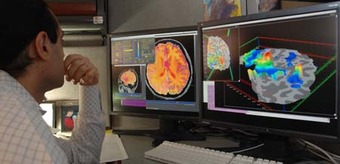
Researcher Test
A researcher studying a part of the human body in search for illness.
19.1.2: Gender and Health
Disparities in health services play out based on different systems of stratification, such as gender.
Learning Objective
Examine the role gender plays in health care services, particularly for women
Key Points
- The World Health Organization defines gender as the result of socially constructed ideas about the behavior, actions, and roles a particular sex performs.
- Gender, and particularly the role of women, is widely recognized as vitally important to international development issues.
- Women’s dual responsibilities as carers and income earners leaves them suffering from time poverty, and thus unable to access health and education services.
- The Gender-related Development Index (GDI), developed by the United Nations, aims to show the inequalities between men and women in the following areas: long and healthy life, knowledge, and a decent standard of living.
- The Gender-related Development Index (GDI), developed by the United Nations, aims to show the inequalities between men and women in the following areas: long and healthy life, knowledge, and a decent standard of living.
Key Terms
- World Health Organization
-
The World Health Organization (WHO) is a specialized agency of the United Nations (UN) that is concerned with international public health. It was established on April 7, 1948, with headquarters in Geneva, Switzerland, and is a member of the United Nations Development Group.
- gender stratification
-
There are a number of ways in which health disparities play out based on different systems of stratification. Researchers also find health disparities based on gender stratification.
- international development
-
International development or global development is a concept that lacks a universally accepted definition, but it is most used in a holistic and multi-disciplinary context of human development—the development of greater quality of life for humans. It therefore encompasses foreign aid, governance, healthcare, education, poverty reduction, gender equality, disaster preparedness, infrastructure, economics, human rights, environment and issues associated with these.
Examples
- One study found that women are less likely than men to be recommended for knee replacement surgery, even when they have the same symptoms. While it was unclear what role the sex of the recommending physicians played, the authors of this study encouraged women to challenge their doctors in order to get care equivalent to men.
- Studies demonstrate the positive impact of girls’ education on child and maternal health, fertility rates, poverty reduction and economic growth. Educated mothers are more likely to send their children to school.
The Role of Gender in Health
Gender is a range of characteristics used to distinguish between males and females, particularly in the cases of men and women and the masculine and feminine attributes assigned to them. Depending on the context, the discriminating characteristics vary, from sex to social role to gender identity. The World Health Organization defines gender as the result of socially constructed ideas about the behavior, actions, and roles a particular sex performs. Assigning gender involves taking into account the physiological and biological attributes assigned by nature followed by socially constructed conduct. The social label of being classified into one or the other sex is obligatory to the medical stamp on the birth certificate.
There are a number of ways in which health disparities play out based on different systems of stratification. Researchers also find health disparities based on gender stratification. One study found that women are less likely than men to be recommended for knee replacement surgery, even when they have the same symptoms. While it was unclear what role the sex of the recommending physicians played, the authors of this study encouraged women to challenge their doctors in order to get care equivalent to men.
Gender, and particularly the role of women, is widely recognized as vitally important to international development issues. This often means a focus on gender-equality, ensuring participation, but includes an understanding of the different roles and expectations of the genders within the community. As recognized by the United Nations, women’s dual responsibilities as carers and income earners leaves them suffering from time poverty, and thus unable to access health and education services. The Gender-related Development Index (GDI), developed by the United Nations, aims to show the inequalities between men and women in the following areas: long and healthy life, knowledge, and a decent standard of living.
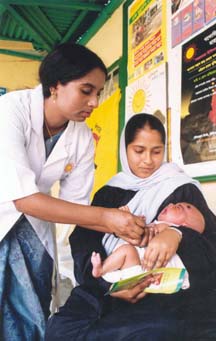
Immunization for Babies
Immunizations from various diseases have improved health worldwide.
19.1.3: Race and Health
Health disparities refer to gaps in the quality of health and healthcare across racial and ethnic groups.
Learning Objective
Discuss the health disparities in the United States based on race and the implications for racial minorities
Key Points
- Race and health research, often done in the United States, has found both current and historical racial differences in the frequency, treatments, and availability of treatments for several diseases.
- In multiracial societies such as the United States, racial groups differ greatly in regard to social and cultural factors such as socioeconomic status, healthcare, diet, and education.
- There is a controversy regarding race as a method for classifying humans. The continued use of racial categories has been criticized.
- Apart from the general controversy regarding race, some argue that the continued use of racial categories in health care, and as risk factors, could result in increased stereotyping and discrimination in society and health services.
Key Terms
- Health disparities
-
Health equity refers to the study of differences in the quality of health and health care across different populations.
- multiracial societies
-
In multiracial societies such as the United States, racial groups differ greatly in regard to social and cultural factors, such as socioeconomic status, healthcare, diet, and education.
- life expectancy
-
The amount of time one is expected to live.
Example
- Health disparities based on race also exist. Similar to the difference in life expectancy found between the rich and the poor, affluent white women live 14 years longer in the U.S. (81.1 years) than poor black men (66.9 years).
The Role of Race in Health
Health disparities refer to gaps in the quality of health and healthcare across racial and ethnic groups. Race and health research, often done in the United States, has found both current and historical racial differences in the frequency, treatments, and availability of treatments for several diseases. This can add up to significant group differences in variables such as life expectancy. Many explanations for such differences have been argued, including socioeconomic factors, lifestyle, social environment, and access to preventive health-care services, among other environmental differences.
In multiracial societies such as the United States, racial groups differ greatly in regard to social and cultural factors such as socioeconomic status, healthcare, diet, and education. There is also the presence of racism which some see as a very important explaining factor. Some argue that for many diseases racial differences would disappear if all environmental factors could be controlled for. Race-based medicine is the term for medicines that are targeted at specific ethnic clusters, which are shown to have a propensity for a certain disorder. Critics are concerned that the trend of research on race specific pharmaceutical treatments will result in inequitable access to pharmaceutical innovation, and smaller minority groups may be ignored.
Health disparities based on race also exist. Similar to the difference in life expectancy found between the rich and the poor, affluent white women live 14 years longer in the U.S. (81.1 years) than poor black men (66.9 years). There is also evidence that blacks receive less aggressive medical care than whites, similar to what happens with women compared to men. Black men describe their visits to doctors as stressful, and report that physicians do not provide them with adequate information to implement the recommendations they are given.
Another contributor to the overall worse health of blacks is the incident of HIV/AIDS; the rate of new AIDS cases is ten times higher among blacks than whites, and blacks are 20 times as likely to have HIV/AIDS as are whites. Health disparities are well documented in minority populations such as African Americans, Native Americans, Asian Americans, and Latinos. When compared to European Americans, these minority groups have higher incidence of chronic diseases, higher mortality, and poorer health outcomes. Minorities also have higher rates of cardiovascular disease, HIV/AIDS, and infant mortality than whites. American ethnic groups can exhibit substantial average differences in disease incidence, disease severity, disease progression, and response to treatment.
Infant mortality is another place where racial disparities are quite evident. In fact, infant mortality rates are 14 of every 1000 births for black, non-Hispanics compared to 6 of every 1000 births for whites. Another disparity is access to health care and insurance. In California, more than half (59 percent) of Hispanics go without health care. Also, almost 25 percent of Latinos do not have health insurance, as opposed to 10 percent of Whites.
There is a controversy regarding race as a method for classifying humans. The continued use of racial categories has been criticized. Apart from the general controversy regarding race, some argue that the continued use of racial categories in health care, and as risk factors, could result in increased stereotyping and discrimination in society and health services. There is general agreement that a goal of health-related genetics should be to move past the weak surrogate relationships of racial health disparity and get to the root causes of health and disease. This includes research which strives to analyze human genetic variation in smaller groups across the world.

Percentage Without Insurance, Based on Race
Age-sex adjusted percent of persons of all ages without health insurance coverage, by race/ethnicity, United States, 2004
19.1.4: Social Class and Health
Social class has a significant impact on one’s physical health, ability to receive adequate medical care and nutrition, and life expectancy.
Learning Objective
Discuss the role social class plays in access to adequate health care and health inequality
Key Points
- While gender and race play significant factors in explaining healthcare inequality in the United States, socioeconomic status is the greatest determining factor in an individual’s level of access to healthcare.
- Social determinants of health are the economic and social conditions, and their distribution among the population, that influence individual and group differences in health status.
- They are risk factors found in one’s living and working conditions (such as the distribution of income, wealth, influence, and power), rather than individual factors (such as behavioral risk factors or genetics) that influence the risk for a disease, injury, or vulnerability to disease or injury.
- Social determinants of health are the economic and social conditions, and their distribution among the population, that influence individual and group differences in health status.
- Health inequality is the term used in a number of countries to refer to those instances whereby the health of two demographic groups (not necessarily ethnic or racial groups) differs despite comparative access to health care services.
Key Terms
- health inequality
-
The unequal distribution of environmental health hazards and access to health services between demographic groups, including social classes.
- social determinants of health
-
The economic and social conditions that influence individual and group differences in health status.
Example
- From the differences in socioeconomic and environmental characteristics of different ethnic and racial groups. For instance, American Africans and Hispanics tend to live in poorer neighborhoods that are near to industrial areas and are older than new suburban subdivisions. Industrial pollutants and lead-paint, common in older homes, can both lead to increased incidents of disease.
The Role of Social Class in Health
A person’s social class has a significant impact on their physical health, their ability to receive adequate medical care and nutrition, and their life expectancy. While gender and race play significant factors in explaining healthcare inequality in the United States, socioeconomic status is the greatest determining factor in an individual’s level of access to healthcare.
Individuals of lower socioeconomic status in the United States experience a wide array of health problems as a result of their economic status. They are unable to use health care as often, and when they do it is of lower quality, even though they generally tend to experience a much higher rate of health issues. Furthermore, individuals of lower socioeconomic status have less education and often perform jobs without significant health and benefits plans, whereas individuals of higher standing are more likely to have jobs that provide medical insurance. Consequently, they have higher rates of infant mortality, cancer, cardiovascular disease, and disabling physical injuries.
Social determinants of health are the economic and social conditions, and their distribution among the population, that influence individual and group differences in health status. They are risk factors found in one’s living and working conditions (such as the distribution of income, wealth, influence, and power), rather than individual factors (such as behavioral risk factors or genetics) that influence the risk for a disease, injury, or vulnerability to disease or injury. According to some viewpoints, these distributions of social determinants are shaped by public policies that reflect the influence of prevailing political ideologies of those governing a jurisdiction.
Health inequality is the term used in a number of countries to refer to those instances whereby the health of two demographic groups (not necessarily ethnic or racial groups) differs despite comparative access to health care services. Such examples include higher rates of morbidity and mortality for those in lower occupational classes than those in higher occupational classes, and the increased likelihood of those from ethnic minorities being diagnosed with a mental health disorder.
19.1.5: Education and Health
Health literacy is an individual’s ability to read, understand and use healthcare information to make decisions about treatment.
Learning Objective
Demonstrate the impact of health literacy on access to and understanding of health care issues, especially for certain social groups
Key Points
- Health literacy is of continued and increasing concern for health professionals, as it is a primary factor behind health disparities.
- While problems with health literacy are not limited to minority groups, the problem can be more pronounced in these groups than in whites due to socioeconomic and educational factors.
- Reading level, numeracy level, language barriers, cultural appropriateness, format and style, sentence structure, use of illustrations, scope of intervention, and numerous other factors will affect how easily health information is understood and followed.
- The mismatch between a clinician’s level of communication and a patient’s ability to understand can lead to medication errors and adverse medical outcomes.
- Health care professionals (doctors, nurses, public health workers) can also have poor health literacy skills, such as a reduced ability to clearly explain health issues to patients and the public.
- The eHealth literacy model is also referred to as the Lily model. This model includes basic literacy, computer literacy, information literacy, media literacy, science literacy, and health literacy.
Key Terms
- the eHealth literacy model
-
The eHealth literacy model is also referred to as the Lily model, which incorporates the following literacies, each of which are instrumental to the overall understanding and measurement of eHealth literacy: basic literacy, computer literacy, information literacy, media literacy, science literacy, health literacy.
- language barrier
-
A figurative phrase for the difficulties faced when people who have no language in common attempt to communicate with each other.
- Health literacy
-
Health literacy is an individual’s ability to read, understand and use healthcare information to make decisions and follow instructions for treatment.
Example
- A review of 119 studies suggested that successful work site health-promotion programs have attributes such as: assessing employees’ health needs and tailoring programs to meet those needs; attaining high participation rates; promoting self care; targeting several health issues simultaneously; and offering different types of activities (e.g., group sessions as well as print materials).
Health literacy is an individual’s ability to read, understand, and use healthcare information to make decisions and follow instructions for treatment. Health literacy is of continued and increasing concern for health professionals, as it is a primary factor behind health disparities. While problems with health literacy are not limited to minority groups, the problem can be more pronounced in these groups than in whites due to socioeconomic and educational factors.
There are many factors that determine the health literacy level of health education materials or other health interventions. Reading level, numeracy level, language barriers, cultural appropriateness, format and style, sentence structure, use of illustrations, scope of intervention, and numerous other factors will affect how easily health information is understood and followed. The mismatch between a clinician’s level of communication and a patient’s ability to understand can lead to medication errors and adverse medical outcomes. The lack of health literacy affects all segments of the population, although it is disproportionate in certain demographic groups, such as the elderly, ethnic minorities, recent immigrants and persons with low general literacy. Health literacy skills are not only a problem in the public. Health care professionals (doctors, nurses, public health workers) can also have poor health literacy skills, such as a reduced ability to clearly explain health issues to patients and the public.
Due to the increasing influence of the internet for information-seeking and health information distribution purposes, eHealth literacy has become an important topic of research in recent years. The eHealth literacy model is also referred to as the Lily model, which incorporates the following literacies, each of which are instrumental to the overall understanding and measurement of eHealth literacy: basic literacy, computer literacy, information literacy, media literacy, science literacy, health literacy.
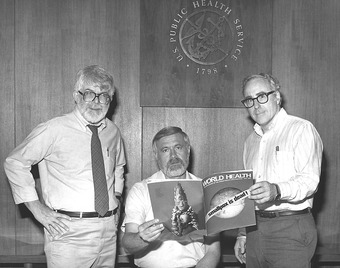
Directors of Global Smallpox Eradication Program
Three former directors of the Global Smallpox Eradication Program read the news that smallpox had been globally eradicated in 1980.
19.1.6: Women in Medicine
Historically and in many parts of the world, women’s participation in the profession of medicine has been significantly restricted.
Learning Objective
Analyze the role women play in the medical field and how gender parity affects women’s choices when it comes to medicine
Key Points
- Women’s informal practice of medicine in the role of caregivers and in the allied health professions has been widespread.
- The practice of medicine remains disproportionately male overall. In industrialized nations, the recent parity in gender of medical students has not yet trickled into parity in practice.
- Most countries now guarantee equal access by women to medical education. However, not all ensure equal employment opportunities, and gender parity has yet to be achieved within the medical specialties around the world.
Key Term
- parity
-
Equality; comparability of strength or intensity.
Example
- In the 21st century, women continue to dominate in nursing. In 2000, 94.6% of registered nurses in the United States were women.
The Role of Women in Medicine
Historically and in many parts of the world, women’s participation in medicine (as physicians, for instance) has been significantly restricted, although women’s informal practice of medicine in the role of caregivers and in the allied health professions has been widespread. Most countries of the world now guarantee equal access by women to medical education, although not all ensure equal employment opportunities. Gender parity has yet to be achieved within the medical specialties around the world.
At the beginning of the twenty-first century in industrialized nations, women have made significant gains, but have yet to achieve parity throughout the medical profession. Women’s participation in medical professions was limited by law and practice during the decades while medicine was professionalizing. However, women kept practicing medicine in the allied health fields (nursing, midwifery), making significant gains in medical education and medical work during the 19th and 20th centuries. Women continue to dominate nursing in the 20th century. In 2000, 94.6% of registered nurses in the United States were women.
The practice of medicine remains disproportionately male overall. In some industrialized nations, women have achieved parity in medical school. Since 2003, women have formed the majority of the U.S. medical student body. However, they have yet to achieve parity in practice. In many developing nations, neither medical school nor practice approach gender parity. Moreover, there are skews within the medical profession. For example, some medical specialties like surgery are significantly male-dominated, while other specialties are or becoming significantly female-dominated.

Monique Frize, née Aubry (born 1942) is a Canadian academic and biomedical engineer known for her expertise in medical instrumentation and decision-support systems
At the beginning of the 21st century, women in industrialized nations have made significant gains, but have yet to achieve parity throughout the medical profession. In some industrialized countries, women have achieved parity in medical school. Women have formed the majority of the United States medical student body since 2003. In 2007-2008, women accounted for 49% of medical school applicants and 48.3% of those accepted. According to the American Association of Medical Colleges (AAMC) 48.3% (16,838) of medical degrees awarded in the US in 2009-10 were earned by women, an increase from 26.8% in 1982-3.
19.2: Sociological Perspectives on Health and Illness
19.2.1: The Functionalist Perspective
In the functionalist model, Parsons argued that illness is a form of deviance that disturbs the social function of a society.
Learning Objective
Discuss the functionalist perspective on illness in society, specifically the role the sick play in a specific society and how that role affects others
Key Points
- Functionalism addresses society as a whole in terms of the function of its constituent elements (namely norms, customs, traditions, and institutions), much like the interacting organs within the human body.
- Prominent functionalist theorists include Auguste Comte, Herbert Spencer, Talcott Parsons, Kingsley Davis and Wilbert E. Moore, Robert Merton, and Gabriel Almond and Bingham Powell.
- Functionalism is a framework that sees society as a complex system whose parts work together to promote solidarity and stability.
- Functionalists argue that a sick individual is not a productive member of society; therefore this deviance needs to be policed. This is the role of the medical profession.
- Structural functionalism reached the peak of its influence in the 1940s and 1950s, and by the 1960s was in rapid decline, replaced by conflict-oriented approaches in Europe and more recently by structuralism.
Key Terms
- structuralism
-
A theory of sociology that views elements of society as part of a cohesive, self-supporting structure.
- deviance
-
Actions or behaviors that violate formal and informal cultural norms, such as laws or the norm that discourages public nose-picking.
Example
- Alzheimer’s disease is considered to affect most of the elderly population. In their Sick Role, people with this disease are not at fault for their sickness and are remove from responsibility of their social roles and need to be taken care of in the daily basis.
Structural functionalism, or simply functionalism, is a framework for building theory that sees society as a complex system whose parts work together to promote solidarity and stability. This approach looks at society through a macro-level orientation, which is a broad focus on the social structures that shape society as a whole. This approach looks at both social structure and social functions. Prominent functionalist theorists include Auguste Comte, Herbert Spencer , Talcott Parsons, Kingsley Davis and Wilbert E. Moore, Robert Merton, and Gabriel Almond and Bingham Powell.
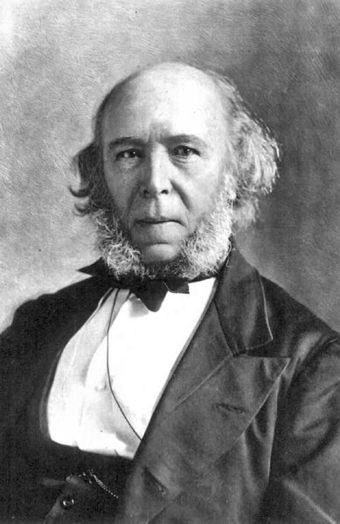
Herbert Spencer
Herbert Spencer was a prominent functionalist sociologist, who likened the functioning parts of society as organs within a body.
Functionalism addresses society as a whole in terms of the function of its constituent elements; namely norms, customs, traditions, and institutions. A common analogy, popularized by Herbert Spencer, presents these parts of society as “organs” that work toward the proper functioning of the “body” as a whole. For Talcott Parsons (1902–1979), an American sociologist, “structural-functionalism” came to describe a particular stage in the methodological development of social science, rather than a specific school of thought.
The Sick Role
Sick role is a term used in medical sociology regarding sickness and the rights and obligations of the affected. It is a concept created by the American sociologist Talcott Parsons in 1951. Parsons was a functionalist sociologist who argued that being sick means that the sufferer enters a role of “sanctioned deviance”. This is because, from a functionalist perspective, a sick individual is not a productive member of society. Therefore this deviance needs to be policed, which is the role of the medical profession.
In the functionalist model, Parsons argued that the best way to understand illness sociologically is to view it as a form of deviance that disturbs the social function of the society. The general idea is that the individual who has fallen ill is not only physically sick, but now adheres to the specifically patterned social role of being sick. “Being Sick” is not simply a “condition”; it contains within itself customary rights and obligations based on the social norms that surround it.
The theory outlined two rights of a sick person and two obligations. The sick person’s rights are twofold: the first one is being exempt from normal social roles; the second one is not being responsible for their condition. Conversely, the sick person’s obligations included trying to get well and cooperating with the medical professionals. Parsons concluded that there are three versions of the sick role: conditional, unconditional legitimate, and illegitimate (a condition stigmatized by others).
Critics of the Functionalist Perspective
Critics of Parsons and the functionalist perspective point to different flaws they see with his argument. The model assumes that the individual voluntarily accepts the sick role. It also assumes that the individual may not comply with expectations of the sick role, may not give up social obligations, may resist dependency, and may avoid the public sick role if their illness is stigmatized. The model also blames the sick, where “rights” do not always apply.
Structural functionalism reached the peak of its influence in the 1940s and 1950s, and by the 1960s was in rapid decline. By the 1980s, its place was taken in Europe by more conflict-oriented approaches, and more recently by “structuralism”. While some of the critical approaches also gained popularity in the United States, the mainstream of the discipline has instead shifted to a myriad of empirically-oriented middle-range theories with no overarching theoretical orientation. To most sociologists, functionalism is now obsolete.
19.2.2: The Conflict Perspective
Conflict theory argues that the economic and political structures of a society create social divisions, inequalities, and conflicts.
Learning Objective
Examine the differing views on conflict theory from various sociologists, such as Karl Marx and C. Wright Mills
Key Points
- Conflict theories are perspectives in social science that emphasize the social, political, or material inequality of a social group.
- Of the classical founders of social science, conflict theory is most commonly associated with Karl Marx, who posited that capitalism would inevitably produce internal tensions leading to its own destruction.
- Marx advocated for the rejection of false consciousness (explanations of social problems as the shortcomings of individuals rather than the flaws of society) and the claiming of class consciousness (workers’ recognition of themselves as a class unified in opposition to the capitalist system).
- The Polish-Austrian sociologist Ludwig Gumplowicz and the American sociologist Lester F. Ward approached conflict from a comprehensive anthropological and evolutionary point-of-view.
- C. Wright Mills has been called the founder of modern conflict theory. In Mills’s view, social structures are created through conflict between people with differing interests and resources.
- Conflict theory is most often associated with Marxism, but may also be associated with other perspectives such as critical theory, feminist theory, postmodern theory, queer theory, and race-conflict theory.
Key Terms
- functionalism
-
Structural functionalism, or simply functionalism, is a framework for building theory that sees society as a complex system whose parts work together to promote solidarity and stability.
- military-industrial complex
-
The armed forces of a nation together with the industries that supply their weapons and materiel.
- capitalism
-
A socio-economic system based on private property rights, including the private ownership of resources or capital, with economic decisions made largely through the operation of a market unregulated by the state.
Example
- In the United States people within the upper and middle class have access to private and full healthcare coverage whereas, for the most part, most of the Americans have no healthcare. According to the US Census Bureau, in 2007, 45.7 million people in the U.S. (15.3% of the population) were without health insurance for at least part of the year. This number was down slightly from the previous year, with nearly 3 million more people receiving government coverage and a slightly lower percentage covered under private plans than the year previous. There is a class conflict and within access to healthcare.
Conflict theories are perspectives in social science that emphasize the social, political, or material inequality of a social group, that critique the broad socio-political system, or that otherwise detract from structural functionalism and ideological conservatism. Sociologists in the tradition of conflict theory argue that the economic and political structures of a society create social divisions, classes, hierarchies, antagonisms and conflicts that produce and reproduce inequalities. Certain conflict theories set out to highlight the ideological aspects inherent in traditional thought. While many of these perspectives hold parallels, conflict theory does not refer to a unified school of thought, and should not be confused with, for instance, peace and conflict studies.
Of the classical founders of social science, conflict theory is most commonly associated with Karl Marx (1818–1883) . Based on a dialectical materialist account of history, Marxism posited that capitalism, like previous socioeconomic systems, would inevitably produce internal tensions leading to its own destruction. Marx ushered in radical change, advocating proletarian revolution and freedom from the ruling classes. At the same time, Karl Marx was aware that most of the people living in capitalist societies did not see how the system shaped the entire operation of society. Just like how we see private property, or the right to pass that property onto our children as natural, many of members in capitalistic societies see the rich as having earned their wealth through hard work and education, while seeing the poor as lacking in skill and initiative. Marx rejected this type of thinking and termed it false consciousness, which involves explanations of social problems as the shortcomings of individuals rather than the flaws of society. Marx wanted to replace this kind of thinking with something Engels termed class consciousness, which is when workers recognize themselves as a class unified in opposition to capitalists and ultimately to the capitalist system itself. In general, Marx wanted the working class to rise up against the capitalists and overthrow the capitalist system .

Healthcare reform supporter
Karl Marx wanted to replace false consciousness with class consciousness, in which the working class would rise up against the capitalist system.
Two early conflict theorists were the Polish-Austrian sociologist and political theorist Ludwig Gumplowicz (1838–1909) and the American sociologist and paleontologist Lester F. Ward (1841–1913). Although Ward and Gumplowicz developed their theories independently, they had much in common and approached conflict from a comprehensive anthropological and evolutionary point-of-view as opposed to Marx’s rather exclusive focus on economic factors.
C. Wright Mills has been called the founder of modern conflict theory. In Mills’s view, social structures are created through conflict between people with differing interests and resources. Individuals and resources, in turn, are influenced by these structures and by the “unequal distribution of power and resources in the society. ” Mills argued that the interests of the power elite of American society (for example, the military-industrial complex) were opposed to those of the people. He theorized that the policies of the power elite would result in the “increased escalation of conflict, production of weapons of mass destruction, and possibly the annihilation of the human race. “
Conflict theory is most commonly associated with Marxism, but as a reaction to functionalism and the positivist method, it may also be associated with a number of other perspectives, including critical theory, feminist theory, postmodern theory, post-structural theory, postcolonial theory, queer theory, world systems theory, and race-conflict theory.
19.2.3: The Interactionist Perspective
According to theorists working in the symbolic interactionist perspective, health and illness are socially constructed.
Learning Objective
Explain and give examples of social constructions of health according to the symbolic interactionist perspective
Key Points
- Symbolic interactionist researchers investigate how people create meaning during social interaction, how they present and construct the self, and how they define situations of co-presence with others.
- Constructivist grounded theory emphasizes the development of an interactive relationship and mutual construction of knowledge between researcher and participants.
- Medicalization of deviance refers to the process that changes “bad” behavior into “sick” behavior.
- Demedicalization refers to the process when “sick” behavior is normalized again.
Key Terms
- symbolic interactionist
-
Symbolic interactionist researchers investigate how people create meaning during social interaction, how they present and construct the self, and how they define situations of co-presence with others.
- medicalization of deviance
-
The medicalization of deviance refers to the process that changes “bad” behavior into “sick” behavior.
- demedicalization
-
Demedicalization refers to the process when “sick” behavior is normalized again.
Example
- An example of medicalization is illustrated by the history of how our society views alcohol and alcoholism. During the 19th century, people who drank too much were considered bad, lazy people. They were called drunks, and it was not uncommon for them to be arrested or run out of a town.
According to theorists working in the symbolic interactionist perspective, health and illness are socially constructed. Symbolic interactionist researchers investigate how people create meaning during social interaction, how they present and construct the self (or “identity”), and how they define situations of co-presence with others. One of the perspective’s central ideas is that people act as they do because of how they define situations.
Constructivist grounded theory emphasizes the development of an interactive relationship and mutual construction of knowledge between researcher and participants. Symbolic interactionists believe that objects have meaning only through people’s interactions with them in the environment, that the meanings people have for things develops through social interaction and that those meanings are handled and modified by a constant and ongoing interpretive process by individuals.
An example of the social construction of health the the Rate of Perceived Exertion, or RPE. This scale measures the intensity of a person’s workout on a scale of 0 to 10. This scale was developed by Gunnar Borg, and it is used by medical professionals to assess a person’s health in a variety of ways.
In essence, interactionists focus on the specific meanings and causes people attribute to illness. The term “medicalization” of deviance” refers to the process that changes “bad” behavior into “sick” behavior. A related process is “demedicalization”, in which “sick” behavior is normalized again. Medicalization and demedicalization affect who responds to the patient, how people respond to the patient, and how people view the personal responsibility of the patient.
An example of medicalization is illustrated by the history of how our society views alcohol and alcoholism. During the 19th century, people who drank too much were considered “bad, lazy people. ” They were called drunks, and it was not uncommon for them to be arrested or run out of a town. Drunks were not treated in a sympathetic way because, at that time, it was thought that it was their own fault that they could not stop drinking . During the latter half of the 20th century, however, people who drank too much were increasingly defined as people with a disease or a genetic predisposition to addiction. With alcoholism defined as a disease and not a personal choice, alcoholics came to be viewed with more compassion and understanding. Thus, “badness” was transformed into “sickness”.

Alcoholism
In this engraving from the 19th century, “King Alcohol” is shown with a skeleton on a barrel of alcohol. The words “poverty,” “misery,” “crime,” and “death” hang in the air behind him.
While interactionism does acknowledge the subjective nature of diagnosis, it is important to remember who benefits the most when a behavior becomes defined as illness. Pharmaceutical companies make billions of dollars treating illnesses such as fatigue, insomnia, and hyperactivity that may not actually be illnesses in need of treatment, but opportunities for companies to make more money.
19.2.4: The Labeling Approach
The labeling approach to health and illness claims that mental illness is manifested solely as a result of societal influence.
Learning Objective
Analyze the pros and cons of labeling theory, especially the implications it has for the “mentally ill” and HIV/AIDS patients
Key Points
- Developed by sociologists during the 1960s, labeling theory holds that deviance is not inherent to an act. The theory focuses on the tendency of majorities to negatively label minorities or those seen as deviant from standard cultural norms.
- The social construction of deviant behavior plays an important role in the labeling process that occurs in society.
- Labeling theory was first applied to the term “mentally ill” in 1966 when Thomas J. Scheff published Being Mentally Ill. Scheff challenged common perceptions of mental illness by claiming that mental illness is manifested solely as a result of societal influence.
- Hard labeling refers to those who argue that mental illness does not exist. They note the slight deviance from the norms of society that cause people to believe in mental illness.
- Soft labeling refers to people who believe that mental illnesses do, in fact, exist. Unlike the supporters of hard labeling, soft labeling supporters believe that mental illnesses are not entirely socially constructed.
Key Terms
- deviance
-
Actions or behaviors that violate formal and informal cultural norms, such as laws or the norm that discourages public nose-picking.
- social construction
-
A concept or practice that is the construct (or artifact) of a particular group, meaning that the concept or practice is understood differently by various groups and institutions.
- self-fulfilling prophecy
-
a prediction that, by being voiced, causes itself to come true
Example
- The label of “mentally ill” may help a person seek help, for example psychotherapy or medication. Labels, while they can be stigmatizing, can also lead those who bear them down the road to proper treatment and recovery.
Labeling Theory on Health and Illness
Labeling theory is closely related to social-construction and symbolic-interaction analysis. Developed by sociologists during the 1960s, labeling theory holds that deviance is not inherent to an act. The theory focuses on the tendency of majorities to negatively label minorities or those seen as deviant from standard cultural norms. The theory is concerned with how the self-identity and behavior of individuals may be determined or influenced by the terms used to describe or classify them. It is associated with the concepts of self-fulfilling prophecy and stereotyping .

1857 Lithograph by Armand Gautier
Shows personifications of dementia, megalomania, acute mania, melancholia, idiocy, hallucination, erotic mania and paralysis in the gardens of the Hospice de la Salpêtrière. A mental disorder or mental illness is a psychological pattern, potentially reflected in behavior, that is generally associated with distress or disability, and which is not considered part of normal development of a person’s culture.
The social construction of deviant behavior plays an important role in the labeling process that occurs in society. This process involves not only the labeling of criminally deviant behavior—behavior that does not fit socially constructed norms—but also labeling that reflects stereotyped or stigmatized behavior of the “mentally ill.” Hard labeling refers to those who argue that mental illness does not exist; it is merely deviance from the norms of society that cause people to believe in mental illness. Mental illnesses are socially constructed illnesses and psychotic disorders do not exist. Soft labeling refers to people who believe that mental illnesses do, in fact, exist, and are not entirely socially constructed.
Labeling theory was first applied to the term “mentally ill” in 1966 when Thomas J. Scheff published Being Mentally Ill. Scheff challenged common perceptions of mental illness by claiming that mental illness is manifested solely as a result of societal influence. He argued that society views certain actions as deviant. In order to come to terms with and understand these actions, society often places the label of mental illness on those who exhibit them. Certain expectations are placed on these individuals and, over time, they unconsciously change their behavior to fulfill them. Criteria for different mental illnesses, he believed, are not consistently fulfilled by those who are diagnosed with them because all of these people suffer from the same disorder. Criteria are simply fulfilled because the “mentally ill” believe they are supposed to act a certain way—over time, they come to do so.
Another issue involving labeling was the rise of HIV/AIDS cases among gay men in the 1980s. HIV/AIDS was labeled a disease of the homosexual and further pushed people into believing homosexuality was deviant. Even today, some people believe contracting HIV/AIDS is punishment for deviant and inappropriate sexual behaviors.
Labels, while they can be stigmatizing, can also lead those who bear them down the road to proper treatment and recovery. The label of “mentally ill” may help a person seek help, such as psychotherapy or medication. If one believes that being “mentally ill” is more than just believing one should fulfill a set of diagnostic criteria, then one would probably also agree that there are some who are labeled “mentally ill” who need help. It has been claimed that this could not happen if society did not have a way to categorize them, although there are actually plenty of approaches to these phenomena that don’t use categorical classifications and diagnostic terms (for example, spectrum or continuum models). Here, people vary along different dimensions, and everyone falls at different points on each dimension.
19.3: Social Epidemiology and Health
19.3.1: Social Epidemiology and Health
Social epidemiology studies the social distribution and social determinants of health.
Learning Objective
Discuss epidemiolgy and its impact on American health care, as well as its beginnings based on Durkheim’s work on suicide
Key Points
- Epidemiology is the study (or the science of the study) of the patterns, causes, and effects of health and disease conditions in defined populations.
- Social epidemiology is defined as “the branch of epidemiology that studies the social distribution and social determinants of health”; or in other words, “both specific features of, and pathways by which, societal conditions affect health”.
- Social epidemiologists generally use social concepts in order to explain patterns of health in the population.
- The roots of social epidemiology go back to the work of Emile Durkheim on suicide, where he explored the differing suicide rates between Protestants and Catholics.
- Use of multilevel models (also known as hierarchical and mixed effects models) involves focusing on both individual-level measures and emergent social properties that have no correlation at the individual level.
Key Terms
- Emile Durkheim
-
David Émile Durkheim (April 15, 1858 – November 15, 1917) was a French sociologist. He formally established the academic discipline and, with Karl Marx and Max Weber, is commonly cited as the principal architect of modern social science and father of sociology.
- Social epidemiology
-
Social epidemiology is defined as “the branch of epidemiology that studies the social distribution and social determinants of health,” that is, “both specific features of, and pathways by which, societal conditions affect health. “
- Multilevel Models
-
Multilevel models are statistical models of parameters that vary at more than one level. These models can be seen as generalizations of linear models (in particular, linear regression), although they can also extend to non-linear models.
Example
- A social epidemiological study can be conducted when a sociologist in the field identifies a cancer cluster around a particular area. Social epidemiologists can help understand the original causes of the cancer cluster by collecting information about the affected people while working with other medical professionals. In this way, the epidemiological study can help point out the health hazard variables that are affecting the cancer cluster.
Epidemiology
Epidemiology is the study (or the science of the study) of the patterns, causes, and effects of health and disease conditions in defined populations. It is the cornerstone of public health, and informs policy decisions and evidence-based medicine by identifying risk factors for disease and targets for preventive medicine. Epidemiologists help with study design, collection and statistical analysis of data, and interpretation and dissemination of results (including peer review and occasional systematic review). Epidemiology has helped develop methodology used in clinical research, public health studies and, to a lesser extent, basic research in the biological sciences.
Major areas of epidemiological study include disease etiology, outbreak investigation, disease surveillance and screening, biomonitoring, and comparisons of treatment effects such as in clinical trials. Epidemiologists rely on other scientific disciplines like biology to better understand disease processes, statistics to make efficient use of the data and draw appropriate conclusions, social sciences to better understand proximate and distal causes, and engineering for exposure assessment.
Social Epidemiology
Social epidemiology is defined as “the branch of epidemiology that studies the social distribution and social determinants of health”; or in other words, “both specific features of, and pathways by which, societal conditions affect health” (Krieger, 2001). The roots of social epidemiology go back Emile Durkheim’s work on suicide .

Émile Durkheim
Durkheim formally established the academic discipline and, with Karl Marx and Max Weber, is commonly cited as the principal architect of modern social science and father of sociology.
In Suicide (1897), Durkheim explores the differing suicide rates between Protestants and Catholics, arguing that stronger social control among Catholics results in lower suicide rates. According to Durkheim, Catholic society has normal levels of integration while Protestant society has low levels. Overall, Durkheim treated suicide as a social fact, explaining variations in its rate on a macro level, considering society-scale phenomena such as a lack of connections between people (group attachment) and a lack of regulations of behavior, rather than the feelings and motivations of individuals. Despite its limitations, Durkheim’s work on suicide has influenced proponents of control theory, and is often mentioned as a classic sociological study. The book pioneered modern social research and served to distinguish social science from psychology and political philosophy.
Social epidemiology may focus on individual-level measures, or on emergent social properties that have no correlation at the individual level. Simultaneous analysis at both levels may even be warranted. Use of such multilevel models is also known as hierarchical and mixed effects models. Social epidemiology overlaps with fields in the social sciences, such as medical anthropology, medical sociology, and medical geography. However, these fields often use health and disease in order to explain specifically social phenomenon (such as the growth of lay health advocacy movements), while social epidemiologists generally use social concepts in order to explain patterns of health in the population.
19.4: Health Care in the U.S.
19.4.1: Health Care in the U.S.
Healthcare in the United States is provided by separate legal entities, often private facilities with governmental insurance for citizens.
Learning Objective
Outline the problems with American health care, primarily due to privatization
Key Points
- Healthcare facilities are largely owned and operated by the private sector.
- The United States is alone among developed nations with the notable absence of a universal healthcare system.
- Publicly-funded insurance is provided to the public through programs, such as Medicare, Medicaid, TRICARE, the Children’s Health Insurance Program, and the Veterans Health Administration.
- Active debate about healthcare reform in the United States concerns questions of a right to healthcare, access, fairness, efficiency, cost, choice, value, and quality.
- Many of the uninsured are the working poor or are unemployed. Although some are healthy and choose to go without it, others have been rejected by insurance companies and are considered “uninsurable”.
Key Terms
- private insurance
-
Private insurance refers to health insurance provided by a non-governmental organization, usually a privately owned or publicly traded corporation.
- the Children’s Health Insurance Program
-
The Children’s Health Insurance Program (CHIP) is a program administered by the United States Department of Health and Human Services that provides matching funds to states for health insurance to families with children. The program was designed to cover uninsured children in families with incomes that are modest but too high to qualify for Medicaid.
- TRICARE
-
is a health care program of the United States Department of Defense Military Health System. TRICARE provides civilian health benefits for military personnel, military retirees, and their dependents, including some members of the Reserve Component.
Examples
- Most Americans under age 65 (59.3%) receive their health insurance coverage through an employer (which includes both private, as well as civilian public-sector employers) under group coverage, although this percentage is declining.
- Most Americans under age 65 (59.3%) receive their health insurance coverage through an employer (which includes both private as well as civilian public-sector employers) under group coverage, although this percentage is declining.
Healthcare in the United States is provided by many separate legal entities. Healthcare facilities are largely owned and operated by the private sector. Health insurance is now primarily provided by the government in the public sector, with 60-65% of healthcare provision and spending coming from programs, such as Medicare, Medicaid, TRICARE, the Children’s Health Insurance Program, and the Veterans Health Administration.
The United States is alone among developed nations with the notable absence of a universal healthcare system. Current estimates put U.S. healthcare spending at approximately 16% of GDP, second highest to East Timor (Timor-Leste) among all United Nations member nations. The U.S. system is primarily one of private insurance, with governmental insurance provided for citizens on the healthcare fringe. Insurance is provided by large-risk bearing corporate entities, which organize healthcare delivery by negotiating pricing and services with provider (physicians and hospitals) organizations. Most Americans under age 65 (59.3%) receive their health insurance coverage through an employer (which includes both private, as well as civilian public-sector employers) under group coverage, although this percentage is declining.
Debates about Healthcare in the United States
Active debate about healthcare reform in the United States concerns questions of a right to health care, access, fairness, efficiency, cost, choice, value, and quality. Some have argued that the system does not deliver equivalent value for the money spent. The United States pays twice as much, yet lags behind other wealthy nations in such measures as infant mortality and life expectancy. Currently, the United States has a higher infant mortality rate than most of the world’s industrialized nations. Around 84.7% of Americans have some form of health insurance; either through their employer or the employer of their spouse or parent (59.3%), purchased individually (8.9%), or provided by government programs (27.8%; there is some overlap in these figures).
Furthermore, the number of persons without health insurance coverage in the United States is one of the primary concerns raised by advocates of healthcare reform. According to the United States Census Bureau, in 2009, there were 50.7 million people in the United States (16.7% of the population) who were without health insurance. Some Americans who do not qualify for government-provided health insurance are not provided health insurance by an employer, and are unable to afford, cannot qualify for, or choose not to purchase private health insurance. Many of the uninsured are the working poor or are unemployed. Although some are healthy and choose to go without it, others have been rejected by insurance companies and are considered “uninsurable. “

U.S. Uninsured in 2007, by income.
This image shows the income distribution of Americans who did not have health insurance coverage in 2007. The data comes from the U.S. Census Bureau’s Current Population Survey in 2008 and the 2009 Annual Social and Economic Supplements–-available here (page 21).
19.4.2: Physicians, Nurses, and Patients
The interactions between physicians, nurses, and patients are central to healthcare.
Learning Objective
Evaluate the importance of positive interactions between physicians, nurses and patients, in terms of satisfaction with health care services
Key Points
- Physicians in the United States include both physicians trained by medical education in the United States, and physicians that are international medical graduates who have progressed through the necessary steps to acquire a medical license to practice in a state.
- Patient’s satisfaction is favored by a good doctor-patient relationship.
- Nursing is a healthcare profession focused on the care of individuals, families, and communities so they may attain, maintain, or recover optimal health and quality of life.
Key Terms
- medical education
-
Medical education is education related to the practice of being a medical practitioner, either the initial training to become a doctor (i.e., medical school and internship), additional training thereafter (e.g., residency and fellowship), or Physician Assistant education.
- doctor-patient relationship
-
The doctor-patient relationship is central to the practice of healthcare and is essential for the delivery of high-quality health care in the diagnosis and treatment of disease.
- patient’s satisfaction
-
Patients’ satisfaction with an encounter with health care service is mainly dependent on the duration and efficiency of care, and how empathetic and communicable the health care providers are.
Example
- The patient is most often ill or injured and in need of treatment by a physician, advanced practice registered nurse, or other health care provider.
Physicians
A physician is a health care provider who practices the profession of medicine, which is concerned with promoting, maintaining or restoring human health through the study, diagnosis, and treatment of disease, injury and other physical and mental impairments. They may focus their practice on certain disease categories, types of patients, or methods of treatment; such physicians are known as specialist medical practitioners. They may also assume responsibility for the provision of continuing comprehensive medical care to individuals, families and communities; these physicians are known as general practitioners.
Medical practice properly requires both a detailed knowledge of the academic disciplines (such as anatomy and physiology) underlying diseases and their treatment, and also a decent competence in its applied practice. Physicians in the United States include both physicians trained by medical education in the United States, and physicians that are international medical graduates who have progressed through the necessary steps to acquire a medical license to practice in a state. The U.S. physicians are an important part of the health care in the United States. Currently, the American College of Physicians uses the term physician to describe all medical practitioners holding a professional medical degree.
Nurses
Nursing is a healthcare profession focused on the care of individuals, families, and communities so they may attain, maintain, or recover optimal health and quality of life. There are a number of educational paths to becoming a professional nurse, which vary greatly worldwide, but all involve extensive study of nursing theory and practice, and training in clinical skills. Nursing Science is a field of knowledge based on the contributions of nursing scientists through peer-reviewed scholarly journals and evidenced-based practice. Nurses care for individuals of all ages and cultural backgrounds, who are healthy and ill, in a holistic manner based on the individual’s physical, emotional, psychological, intellectual, social, and spiritual needs. The profession combines physical science, social science, nursing theory, and technology in caring for those individuals.
Patients
A patient is any recipient of health care services. The patient is most often ill or injured and in need of treatment by a physician, advanced practice registered nurse, or other health care provider. Patients’ satisfaction with an encounter with health care service is mainly dependent on the duration and efficiency of care, and how empathetic and communicable the health care providers are. It is favored by a good doctor-patient relationship. Also, patients that are well informed of the necessary procedures in a clinical encounter, and the time it is expected to take, are generally more satisfied even if there is a longer waiting time.

A Doctor Performs a Cataract Surgery
A local doctor performs a cataract surgery on a patient at Zamboanga Medical Center during the U.S. Military Sealift Command (MSC) hospital ship, USNS Mercy (T-AH 19) visit to the city on a scheduled humanitarian visit.
19.4.3: Alternatives to Traditional Health Care
Alternative medicine is any practice claiming to heal “that does not fall within the realm of conventional medicine.”
Learning Objective
Break down the various types of alternative medicine and how they fit into the health care system
Key Points
- Alternative medicine is frequently grouped with complementary medicine or integrative medicine, which, in general, refers to the same interventions when used in conjunction with mainstream techniques, under the umbrella term complementary and alternative medicine, or CAM.
- Whole medical systems cut across more than one of the other groups; examples include traditional Chinese medicine, naturopathy, homeopathy, and Ayurveda.
- Mind-body medicine takes a holistic approach to health that explores the interconnection between the mind, body, and spirit.
- Biology-based practices use substances found in nature such as herbs, foods, vitamins, and other natural substances.
- Manipulative and body-based practices feature manipulation or movement of body parts, such as is done in chiropractic and osteopathic manipulation.
- Integrative medicine is the combination of the practices and methods of alternative/complementary medicine with conventional medicine.
Key Terms
- integrative medicine
-
Integrative medicine is the combination of the practices and methods of alternative/complementary medicine with conventional medicine. It may include preventive medicine and patient-centered medicine.
- manipulative and body-based practices
-
Manipulative and body-based practices feature manipulation or movement of body parts, such as is done in chiropractic and osteopathic manipulation.
- mind-body medicine
-
Mind-body medicine takes a holistic approach to health that explores the interconnection between the mind, body, and spirit.
Example
- Whole medical systems cut across more than one of the other groups; examples include traditional Chinese medicine, naturopathy, homeopathy, and Ayurveda. Mind-body medicine takes a holistic approach to health that explores the interconnection between the mind, body, and spirit.
Non-Conventional and Conventional Medicine
Alternative medicine methods are diverse in their foundations and methodologies, and they may be based on historical or cultural traditions, rather than on scientific evidence. Methods may incorporate or base themselves on traditional medicine, folk knowledge, spiritual beliefs, or newly conceived approaches to healing. Alternative medicine is frequently grouped with complementary medicine or integrative medicine, which, in general, refers to the same interventions when used in conjunction with mainstream techniques, under the umbrella term complementary and alternative medicine, or CAM.
There is no clear and consistent definition for either alternative or complementary medicine. In Western culture, it is often defined as any healing practice “that does not fall within the realm of conventional medicine,” or “that which has not been shown consistently to be effective. ” There is a debate among medical researchers over whether any therapy may be properly classified as “alternative medicine. ” Some claim that there is only medicine that has been adequately tested and that which has not. They feel that healthcare practices should be classified based solely on scientific evidence.
The U.S. National Center for Complementary and Alternative Medicine (NCCAM) has developed one of the most widely used classification systems for the branches of complementary and alternative medicine. It classifies complementary and alternative therapies into five major groups, which have some overlap. Whole medical systems cut across more than one of the other groups; examples include traditional Chinese medicine, naturopathy, homeopathy, and Ayurveda. Mind-body medicine takes a holistic approach to health that explores the interconnection between the mind, body, and spirit. Biology-based practices use substances found in nature, such as herbs, foods, vitamins, and other natural substances. Manipulative and body-based practices feature manipulation or movement of body parts, such as is done in chiropractic and osteopathic manipulation.
Integrative medicine is the combination of the practices and methods of alternative/complementary medicine with conventional medicine. It may include preventive medicine and patient-centered medicine. It may also include practices not normally referred to as medicine, such as using prayer, meditation, socializing, and recreation as therapies. Its academic proponents sometimes recommend misleading patients by using known placebo treatments in order to achieve a placebo effect.

Medicinal Herbs
Medicinal herbs in a traditional Spanish market
19.4.4: The Role of Government
Publicly funded health care is a form of healthcare financing designed to meet the cost of healthcare needs from a publicly managed fund.
Learning Objective
Analyze the role of the government in the provision of health care
Key Points
- Most developed countries, with the exception of the United States, have partially or fully, publicly funded health systems.
- Publicly funded healthcare systems are usually financed in one of two ways: through taxation or via compulsory national health insurance.
- In compulsory insurance models, healthcare is financed from some combination of employees’ salary deductions, employers’ contributions, and possibly additional state funds. Insurance may cover other benefits, as well as health.
- When taxation is the primary means of financing healthcare, all eligible people receive the same level of cover regardless of their financial circumstances or risk factors.
- Most western industrial countries have a system of social insurance based on the principle of social solidarity covers eligible people from bearing the direct burden of most healthcare expenditure, funded by taxation during their working life.
- A range of measures, such as better payment methods, has improved the microeconomic incentives facing healthcare providers.
Key Terms
- Publicly funded health care
-
Publicly funded healthcare is a form of healthcare financing designed to meet the cost of all or most healthcare needs from a publicly managed fund.
- compulsory insurance models
-
In compulsory insurance models, healthcare is financed from some combination of employees’ salary deductions, employers’ contributions, and possibly additional state funds. Insurance may cover other benefits as well as health.
- social solidarity
-
Most western industrial countries have a system of social insurance based on the principle of social solidarity covers eligible people from bearing the direct burden of most healthcare expenditure, funded by taxation during their working life.
Example
- Most developed countries, with the exception of the United States, have partially or fully publicly funded health systems.
Government and Healthcare
Publicly funded health care is a form of healthcare financing designed to meet the cost of all or most healthcare needs from a publicly managed fund. The fund may be a not-for-profit trust, which pays out for health care according to common rules established by the members or by some other democratic form. In some countries, the fund is controlled directly by the government or by an agency of the government for the benefit of the entire population. This distinguishes it from other forms of private medical insurance. In the private model, the rights of access are subject to contractual obligations between an insurer and an insurance company. The latter seeks to make a profit by managing the flow of funds between funders and providers of health care services.
Publicly funded healthcare systems are usually financed in one of two ways: through taxation or via compulsory national health insurance. In compulsory insurance models, healthcare is financed from some combination of employees’ salary deductions, employers’ contributions, and possibly additional state funds. Insurance may cover other benefits as well as health. When taxation is the primary means of financing healthcare, all eligible people receive the same level of cover regardless of their financial circumstances or risk factors.
Most developed countries, with the exception of the United States, have partially or fully publicly funded health systems. Most western industrial countries have a system of social insurance based on the principle of social solidarity covers eligible people from bearing the direct burden of most healthcare expenditure, funded by taxation during their working life. Many OECD countries have implemented reforms to achieve policy goals of ensuring access to healthcare, improving the quality of healthcare and health outcomes, allocating an appropriate level of public sector other resources to healthcare, while at the same time ensuring that services are provided in a cost-efficient and cost-effective manner (microeconomic efficiency). A range of measures, such as better payment methods, has improved the microeconomic incentives facing providers. However, introducing improved incentives through a more competitive environment among providers and insurers has proved difficult.
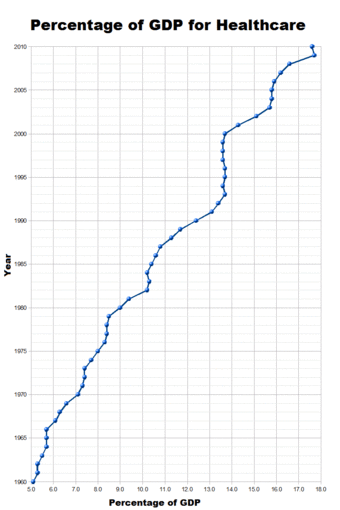
Health Costs USA GDP
Total U.S. healthcare spending from 1960 to 2007 by percent of GDP (gross domestic product)
19.5: Modern Issues in Health Care
19.5.1: Colonialism and the Spread of Diseases
European colonization contributed to the spread of disease worldwide.
Learning Objective
Summarize the impact of European colonialism on the spread of infectious disease and beginnings of disease control
Key Points
- Colonialism is the policy or practice of acquiring full or partial political control over another country, occupying it with settlers, and exploiting it economically.
- Encounters between explorers and populations in the rest of the world often introduced new diseases, which sometimes caused local epidemics of extraordinary virulence.
- Trade routes and new world conquests devastated indigenous populations, as they were exposed to new pathogens and newly domesticated animals.
- The leading cause of death in Europe and North America in the nineteenth century was tuberculosis.
- In the twentieth century, the world saw the biggest increase in its population in human history due to lessening of the mortality rate in many countries due to medical advances.
- In the 20th century, the world saw the biggest increase in its population in human history due to lessening of the mortality rate in many countries due to medical advances.
Key Terms
- pathogen
-
Any organism or substance, especially a microorganism, capable of causing disease, such as bacteria, viruses, protozoa, or fungi. Microorganisms are not considered to be pathogenic until they have reached a population size that is large enough to cause disease.
- tuberculosis
-
An infectious disease of humans and animals caused by a species of mycobacterium mainly infecting the lungs where it causes tubercles characterized by the expectoration of mucus and sputum, fever, weight loss, and chest pain, and transmitted through inhalation or ingestion of bacteria.
- mortality rate
-
The number of deaths per given unit of population over a given period of time.
Examples
- Trade routes and new world conquests devastated indigenous populations, while being exposed to new pathogens and newly domesticated animals. It is estimated that new virgin soil epidemics (pathogens introduced by Europeans in previously uninfected areas) decimated over “90 percent of the population in Meso-America and the Andes” during the sixteenth century. Furthermore, sexual transmission of disease grew with colonization.
- In the 20th century, the world saw the biggest increase in its population in human history due to lessening of the mortality rate in many countries due to medical advances. The world population has grown from 1.6 billion in 1900 to over 7 billion today.
Colonialism and Health
Colonialism is the policy or practice of acquiring full or partial political control over another country, occupying it with settlers, and exploiting it economically. Historically, this has often involved killing or subjugating the indigenous population. Encounters between explorers and populations in the rest of the world often introduced new diseases, which sometimes caused local epidemics of extraordinary virulence.
European colonization contributed to the spread of disease worldwide. Trade routes and New World conquests devastated indigenous populations, as they were exposed to new pathogens and newly domesticated animals. Colonization in Africa and parts of Asia was not as simple for Europeans as it was in the Americas, because Europeans were subjected to diseases they had no prior exposure to. In response to becoming infected, European military and government officials living in African and Asian colonies were quarantined to safety in areas away from natives, who were believed to be disease carriers, and, thus, “biologically inferior. ” The leading cause of death in Europe and North America in the nineteenth century was tuberculosis.
The European contribution to global pathogen exposure created a “global homogenization of disease,” where no border was left uncrossed in the spread of infectious diseases. The ill health effects are long lasting, especially because the health of Europeans improved while the health of colonized nations worsened. Following the end of colonization, many countries continued to use and attempted to enhance their “inherited” healthcare systems, which consisted of “inadequate,” and “top-heavy” structures based on Western medical models. These same models continued to benefit elites and addressed the “rural poor” once the “needs of the urban elite were attended to. ” Hospitals in metropolitan areas were first priority, followed by small rural clinics that were underfunded, understaffed, and, thus, less effective.
From the beginning of the twentieth century onwards, the elimination or control of disease in tropical countries became a driving force for all colonial powers. The sleeping sickness epidemic in Africa was arrested due to mobile teams systematically screening millions of people at risk. In the twentieth century, the world saw the biggest increase in its population in human history due to lessening of the mortality rate in many countries due to medical advances. The world population has grown from 1.6 billion in 1900 to over 7 billion today.

Florentine Codex smallpox
Aztecs dying of smallpox, (“The Florentine Codex,” 1540–85)
19.5.2: Infectious Diseases Today and in the Developing World
Infectious diseases result from the infection, presence and growth of pathogenic biological agents in an individual host organism.
Learning Objective
Assess the implications of infectious diseases in terms of health care and life expectancy of individuals
Key Points
- Many infectious diseases that killed by the millions were greatly reduced in the 20th century.
- While the number of deaths due to nearly every disease has decreased, deaths due to HIV/AIDS have increased fourfold.
- Infectious pathogens include some viruses, bacteria, fungi, protozoa, multicellular parasites, and aberrant proteins known as prions.
- The top three single agent/disease killers are HIV/AIDS, tuberculosis and malaria.
- Normally not a problem to North Americans, malaria is the infectious disease most deadly to children worldwide. Malaria infects 500 million people per year, killing just fewer than 3 million.
- HIV/AIDS is the world’s leading cause of death; it was introduced as an infectious disease during the 20th century.
Key Term
- pathogen
-
Any organism or substance, especially a microorganism, capable of causing disease, such as bacteria, viruses, protozoa, or fungi. Microorganisms are not considered to be pathogenic until they have reached a population size that is large enough to cause disease.
Example
- Malaria infects 500 million people per year, killing just fewer than 3 million. Malaria is the second leading cause of death in Africa, after HIV/AIDS and is the fifth leading cause of death from infectious diseases worldwide.
Infectious diseases, also known as transmissible diseases or communicable diseases, are clinically evident illnesses resulting from the infection, presence and growth of pathogenic biological agents. Infectious pathogens include some viruses, bacteria, fungi, protozoa, multicellular parasites, and aberrant proteins known as prions. These pathogens are the cause of disease epidemics, in the sense that without the pathogen, no infectious epidemic occurs.
Many infectious diseases that previously killed by the millions were greatly reduced in the 20th century, with the most notable achievement being the eradication of smallpox. Other diseases, such as diphtheria, typhoid fever, tuberculosis and whooping cough were greatly reduced throughout the world due to childhood immunization programs, improved sanitation, and the use of antibiotics. However, some infectious diseases remain a problem today. The top three single agent/disease killers are HIV/AIDS, tuberculosis and malaria.
Malaria
Normally not a problem to North Americans, malaria is the infectious disease most deadly to children worldwide. Said to be one of the world’s oldest diseases, malaria is caused by one of four protozoans within the genus Plasmodium. The blood pulled from the bite of an Anopheles mosquito carries this disease, which infects the human or animal host and resides in red blood cells in order to reproduce. Malaria infects 500 million people per year, killing just fewer than 3 million. It is the second leading cause of death in Africa, after HIV/AIDS, and is the fifth leading cause of death from infectious diseases worldwide.
HIV/AIDS
HIV/AIDS was introduced as an infectious disease during the 20th century and deaths due to HIV have increased fourfold since. The first cases were diagnosed in the United States in the early 1980s. This misunderstood illness was originally thought to only exist among four risk groups, better known as the 4Hs: Homosexuals, Haitians, Hemophiliacs and Heroin users. However, as HIV/AIDS has become a pandemic, it is better understood and is known to not just be isoloated to certain groups of people. There are various modes of HIV transmission which include: male to male sexual contact, injection drug use, and heterosexual contact. In some developing countries where antiretroviral drugs are not affordable or readily accessible, mother-to-child transmission still poses a possible risk of infection.
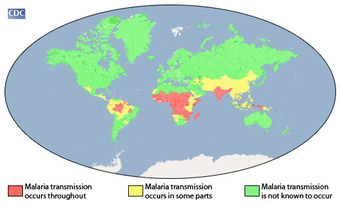
Concentrations of malaria transmission worldwide.
Normally not a problem to North Americans, malaria is the infectious disease most deadly to children worldwide. Said to be one of the world’s oldest diseases, malaria is caused by one of four protozoans within the genus Plasmodium.
19.5.3: HIV and AIDS
HIV/AIDS is a major health problem in many parts of the world.
Learning Objective
Describe the problems associated with HIV/AIDS for many societies, particularly poor countries and ethnic minorities
Key Points
- Acquired immune deficiency syndrome or acquired immunodeficiency syndrome (AIDS) is a disease of the human immune system caused by the human immunodeficiency virus (HIV). The virus and disease are often referred to together as HIV/AIDS.
- The three main transmission routes of HIV are sexual contact, exposure to infected body fluids or tissues, and from mother to fetus during the perinatal period.
- The symptoms of AIDS are primarily the result of conditions that do not normally develop in individuals with healthy immune systems.
- There is currently no publicly available HIV vaccine or cure for HIV or AIDS. The only known methods are based on avoiding exposure to the virus.
Key Terms
- transmission
-
HIV is transmitted by three main routes: sexual contact, exposure to infected body fluids or tissues and from mother to child during pregnancy, delivery or breastfeeding.
- vaccine
-
A substance given to stimulate the body’s production of antibodies providing immunity against a disease, prepared from the agent that causes the disease, or a synthetic substitute.
- perinatal period
-
Of or pertaining to the time around birth.
Example
- The topic of religion and AIDS has become highly controversial in the past 20 years. This is largely due to many prominent religious leaders publicly declaring their opposition to the use of condoms. A report by American health expert Matthew Hanley titled “The Catholic Church and the Global AIDS Crisis” argues that cultural, religion-based changes are needed. These include a re-emphasis on fidelity within marriage and sexual abstinence outside of it.
HIV and AIDS in Health Care
Acquired immune deficiency syndrome or acquired immunodeficiency syndrome (AIDS) is a disease of the human immune system caused by the human immunodeficiency virus (HIV). The illness interferes with the immune system, making people with it much more likely to get infections that do not affect people with working immune systems. This susceptibility gets worse as the disease continues. HIV is transmitted through sexual intercourse, contaminated blood transfusions and hypodermic needles. It can also be transmitted between mother and baby during pregnancy, childbirth and breastfeeding. It can be transmitted by any contact of a mucous membrane or the bloodstream with a bodily fluid that has the virus in it, including blood, semen, vaginal fluid, preseminal fluid, or breast milk.
The virus and disease are often referred to together as HIV/AIDS. The disease is a major health problem in many parts of the world, and is considered a pandemic; a disease outbreak that is not only present over a large area but is actively spreading. In 2009, the World Health Organization (WHO) estimated that there are 33.4 million people worldwide with HIV/AIDS; 2.7 million new HIV infections are reported per year along with two million annual deaths due to AIDS. The three main transmission routes of HIV are sexual contact, exposure to infected body fluids or tissues, and from mother to fetus during the perinatal period. It is possible to find HIV in saliva, tears and urine of infected individuals, but there are no recorded cases of infection by these secretions. Anti-retroviral treatment of infected patients also significantly reduces their ability to transmit HIV to others. This treatment reduces the amount of virus in bodily fluids to undetectable levels
People with AIDS also have an increased risk of developing various cancers like Kaposi’s sarcoma, cervical cancer and cancers of the immune system known as lymphomas. In addition, people with AIDS often have systemic symptoms of infection like fevers, sweats (particularly at night), swollen glands, chills, weakness, and weight loss. The opportunistic infections AIDS patients develop depend in part on the prevalence of these infections in the patient’s geographic area. Symptoms of AIDS are primarily the result of conditions that do not normally develop in individuals with healthy immune systems. Most of these conditions are opportunistic infections caused by bacteria, viruses, fungi and parasites normally controlled by the elements of the immune system that HIV damages. These infections affect nearly every organ system.
Many people are unaware that they are infected with HIV. Less than 1% of the sexually active urban population in Africa has been tested; this proportion is even lower in rural populations. Furthermore, only 0.5% of pregnant women attending urban health facilities are counseled, tested or receive their test results. Again, this proportion is even lower in rural health facilities. Therefore, donor blood and blood products used in medicine and medical research are screened for HIV.
There is currently no publicly available HIV vaccine or cure for HIV or AIDS. The only known methods are based on avoiding exposure to the virus or, failing that, an antiretroviral treatment given directly after a highly significant exposure. This treatment is called post-exposure prophylaxis (PEP). PEP has a very demanding four-week schedule of dosage. It also has very unpleasant side effects, including diarrhea, malaise, nausea and fatigue.

AIDS awareness in Chimoio
AIDS awareness painting on a wall in Chimoio town, Mozambique.
19.5.4: Health Insurance
Health insurance is insurance against the risk of incurring personal medical expenses.
Learning Objective
Discuss the use of both private and public health insurance and the implications for society’s overall health
Key Points
- Two types of health insurance have developed in modern society: private health insurance and publicly funded health insurance.
- A premium is the amount a policy-holder or his sponsor must pay to a health plan in order to purchase health coverage.
- A deductible is the amount that the insured must pay out-of-pocket before the health insurer pays its share.
- Co-payment is the amount that an insured person must pay out of pocket before a health insurer pays for a particular visit or service.
- An explanation of benefits is a document that may be sent by an insurer to a patient. This document explains what was covered for a medical service, and how payment amounts and patient responsibility amounts were determined.
- The premium is the amount the policy-holder or his sponsor pays to the health plan to purchase health coverage.
- The deductible is the amount that the insured must pay out-of-pocket before the health insurer pays its share.
- Co-payment is the amount that the insured person must pay out of pocket before the health insurer pays for a particular visit or service.
- Explanation of benefits is a document that may be sent by an insurer to a patient explaining what was covered for a medical service, and how payment amount and patient responsibility amount were determined.
- The medical model of medicine science focuses on the eradication of illness through diagnosis and effective treatment.
- The social model of medicine science focuses on changes that can be made in society and in people’s own lifestyles to make the population healthier.
Key Terms
- premium
-
The premium is the amount a policy-holder or his sponsor must pay to a health plan to purchase health coverage.
- deductible
-
A deductible is the amount that the insured must pay out-of-pocket before the health insurer pays its share.
- co-payment
-
A co-payment is the amount that the insured person must pay out of pocket before the health insurer pays for a particular visit or service.
Example
- In 2001, the United States government spent $4,887 per person on health care. That is more than double the rate of any other G8 country, except Japan, which spends close to $2,627 per capita annually. Considering the fact that private insurers are supposed to cover the majority of health care costs in the U.S., it is somewhat surprising that the United States spends a greater fraction of its national budget on health than Canada, Germany, France, or Japan. One explanation for the higher health care costs in the U.S. is the billing approach. In the U.S., many doctors work on a fee-for-service basis, which means they earn more if they do more tests or are consulted more frequently. In contrast, doctors who are salaried have no financial incentive to perform unnecessary tests. This was the explanation given for the wide disparity in Medicare spending for patients in the last two years of their lives at top teaching hospitals. For example, per patient costs at UCLA was $93,000, but only $53,000 at the Mayo Clinic. When doctors are salaried, they are not inclined to perform unnecessary tests to increase their income. Doctors using fee-for-service approaches do have that financial incentive. The quality of care and patient life expectancy did not differ between these two hospitals, despite the substantial difference in costs.
Health insurance is insurance against the risk of incurring personal medical expenses. By estimating the overall risk of health care that a target group will require, an insurer can develop a routine finance structure, such as a monthly premium or payroll tax, to ensure that money is available to pay for the health care benefits specified in an insurance agreement. These benefits are administered by a central organization, like a government agency, private business, or non-profit organization.
Types of Health Insurance: Public Vs. Private
Two types of health insurance exist in modern society, private health insurance and publicly funded health insurance. Private insurance, based on free market principles, refers to health insurance provided by a non-governmental organization, usually a privately owned or publicly traded corporation. Among developed nations, the United States is the only country in which private insurance is the primary source of healthcare.
In contrast to this private method, in public insurance, health care is paid wholly or mostly by public funds. This type of health care is the most common and popular in almost every developed and developing nation in the world, except the United States. The majority of developed nations have publicly funded health systems that cover a majority of the population.
Understanding Health Insurance Terms
Some of the essential terms associated with health insurance are premiums, deductibles, co-payments, and explanations of benefits. A premium is the amount a policy-holder or his sponsor (e.g. an employer) must pay to a health plan to purchase health coverage. A deductible is the amount that an insured individual must pay out-of-pocket before the health insurer pays its share. For example, policyholders might have to pay a $500 deductible per year, before the health insurer covers any health care costs. A co-payment is the amount that an insured person must pay out of pocket before the health insurer pays for a particular visit or service. For example, an insured person might pay a $45 co-payment for a doctor’s visit, or to obtain a prescription. A co-payment must be made each time a particular service is obtained. Lastly, an explanation of benefits is a document that may be sent by an insurer to a patient. This document explains what the insurer will cover, in terms of medical services. It also explains how payment amounts and patient responsibility amounts have been determined.
Healthcare and Modern Medicine
Healthcare improves as a result of advancements in medical science. Modern medicine approaches health care from two angles. The first, the medical model, focuses on the eradication of illness through diagnosis and effective treatment. The second, the social model, focuses on changes that can be made in society and in people’s lifestyles to make the population healthier. This second method typically focuses on preventative care. Modern, scientific medicine has proven uniquely effective at treating and preventing disease. It is increasingly widespread and more widely accepted than other forms of medicine. Modern medicine is notably secular, and indifferent to ideas of the supernatural or the spiritual. Instead, it concentrates on the body and society to determine the causes and cures of health issues. Modern, scientific medicine is the most effective contributor to the health of humans in the world today.

In less than 10 Years, AMERICA will Spend $1 of Every $5 Dollars on Health care
Across the country, American workers, their families, and small businesses are struggling with rising health care costs and policies that put quality, affordable care out of reach. A new report by the Centers for Medicare and Medicaid Services (CMS), published in the magazine Health Affairs, estimates that spending on health care grew to 17.3 percent of the U.S. economy – a record and the largest one-year jump since 1960.
19.5.5: Preventing Illness
Preventive medicine, or preventive care, refers to measures taken to prevent diseases, rather than curing them or treating their symptoms.
Learning Objective
Explain the purpose of preventive medicine and how insurance companies can influence the types of preventive medicine chosen
Key Points
- Preventive care may include examinations and screening tests tailored to an individual’s age, health, and family history.
- Preventive medicine or preventive care refers to measures taken to prevent diseases rather than curing them or treating their symptoms.
- Professionals involved in the public health aspect of this practice may be involved in entomology, pest control, and public health inspections.
- Intrauterine devices (IUD) are highly effective and highly cost effective contraceptives, however where universal health care is not available the initial cost may be a barrier.
Key Terms
- intrauterine device
-
A contraceptive device consisting of a spiral or similar shape of plastic or metal inserted through the vagina into the uterus in order to prevent the implantation of a fertilized egg.
- public health
-
The science and practice of community hygiene; it includes preventive medicine, health education, sanitation and environmental safety.
- preventive medicine
-
Preventive medicine refers to measures taken to prevent diseases rather than curing them or treating their symptoms.
Example
- Many vaccines are prophylactic vaccines. Polio vaccine, smallpox vaccine, measles vaccine, mumps vaccine and others have greatly reduced many childhood diseases. HPV vaccines prevent certain cancers, and the influenza vaccine prevents influenza.
Preventive medicine, or preventive care, refers to measures taken to prevent diseases, rather than curing them or treating their symptoms. The term contrasts in method with curative and palliative medicine, and in scope with public health methods, which work at the level of population health rather than individual health. Simple examples of preventive medicine include hand washing, breastfeeding, and immunizations. Preventive care may include examinations and screening tests tailored to an individual’s age, health, and family history. For example, a person with a family history of certain cancers or other diseases would begin screening at an earlier age and/or more frequently than those with no such family history.
Professionals involved in the public health aspect of this practice may be involved in entomology, pest control, and public health inspections. Public health inspections can include recreational waters, swimming pools, beaches, food preparation and serving, and industrial hygiene inspections and surveys.
Since preventive medicine deals with healthy individuals or populations, the costs and potential harms from interventions need even more careful examination than in treatment. For an intervention to be applied widely it generally needs to be affordable and highly cost effective. For instance, intrauterine devices (IUD) are highly effective and highly cost effective contraceptives, however where universal health care is not available the initial cost may be a barrier. Preventive solutions may be less profitable and therefore less attractive to makers and marketers of pharmaceuticals and medical devices. Birth control pills, which are taken every day and may take in a thousand dollars over ten years, may generate more profits than an IUD, which despite a huge initial markup only generates a few hundred dollars over the same period.

Leading Preventable Causes of Death in the United States.
This data is outdated and was in fact significantly revised in subsequent reports of the leading causes of deaths, especially for obesity-related diseases.
